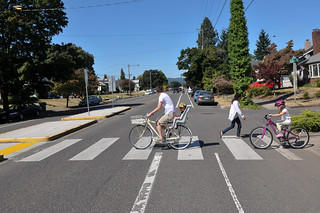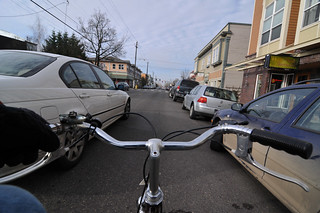Written by lawyer Ray Thomas of Swanson, Thomas Coon & Newton.
Some road users go out of their way (and beyond the law) to be “nice.” Being nice isn’t always a bad thing. Sometimes it involves giving somebody a break, or allowing a successful traffic merge; but other times — such as when a driver waves another driver through stopped traffic — there can be disastrous consequences.
When road users go out of their way to accommodate others when there is no legal authority for doing so, it creates real trouble later if someone gets hurt as a result of their “nice” gesture. In this column, I’ll go over some common scenarios where being what you think is good can actually be very bad.
In heavy traffic situations, most people attempt to honor the Oregon law prohibiting blocking, or “impeding traffic” (ORS 811.130) or “plugging” intersections so that cross traffic can get through (ORS 811.550 prohibits stopping “within an intersection.”) However, some drivers, in an attempt to be helpful, wave other drivers through without considering that someone on a bicycle in an adjacent lane may be lawfully occupying the area in the direct path of the left turning driver.
When a collision happens, many times the “helpful” driver is gone from the scene, leaving an injured person and a baffled driver behind wondering who initiated the collision.
When a collision happens, many times the “helpful” driver is gone from the scene, leaving an injured person and a baffled driver behind wondering who initiated the collision. Sometimes, when the “waver” stays behind it is possible to make a claim against their insurance company for failing to carefully assess other traffic before making the wave. In essence the waver is assuming responsibility for conditions being safe to make the left turn.
Before one attempts to wave someone through they should always do a shoulder check for walkers, bikers and other overtaking traffic to make sure that they’re not about to create a wreck for others road users.
Sometimes a bicycle rider who’s nervous about a left or right turning car next to a bicycle lane will wave them through in an attempt to avoid a potential conflict. This maneuver endangers other overtaking bike riders or people walking in crosswalks who aren’t anticipating that the driver will suddenly start moving when they should have slowed or stopped in order to yield to the person in the bicycle lane (as Oregon law requires). This maneuver is particularly dangerous for bike riders who aren’t anticipating that a rider ahead of them has waved the driver through the bike lane.
Next time you consider doing this, think to yourself: Are you sure you want to avoid a potential conflict so much that you are willing to assume responsibility for other road users the driver might hit on their way across the road in front of you?
Some riders attempt to facilitate overtaking cars’ efforts to pass a group or single rider, for example on a long climb where the riders are going substantially below normal motor vehicle speed. In these instances the lead rider will wave an overtaking car forward when it appears that the lane ahead is clear of oncoming traffic. However the helpful waver has invited what may be an unsafe passing maneuver. In these instances we recommend riding single or double file as far to the right as practical (as required by ORS 814.430). It’s best for riders to allow overtaking auto drivers to decide for themselves when it’s safe to pass — without inviting a passing maneuver which may cause a head-on or side-swipe collision.
One of the reasons Oregon Walks and other organizations changed Oregon law for walking in crosswalks was to create q legal trigger of the walkers’ right of way so that drivers know when to stop before they enter the kill zone. The Oregon crosswalk law (ORS 811.028(5)) states that drivers must stop for people walking in marked or unmarked crosswalks “when any part or extension of the pedestrian, including but not limited to any part of the pedestrian’s body, wheelchair, cane, crutch or bicycle, moves on to the roadway in a crosswalk with the intent to proceed.”
Under the current Oregon system, people who are hanging back on the curb but have not stepped or rolled off of the curb into the crosswalk (unless they are proceeding with a walk signal at a signalized intersection) have not yet exercised their right of way to the crosswalk. Many Oregon drivers (and bikers) are ignorant of crosswalk laws and fail to realize that it is not until the person has actually moved off of the curb and put a foot or bicycle wheel onto the crosswalk in the roadway that an obligation to stop is legally triggered.
The gratuitous granting of a right-of-way that does not yet exist only serves to lure people off of the curb and into a “double-threat” hazard situation because people driving in other lanes might have no idea what’s going on.
Further, ORS 814.040 states pedestrians must yield the right of way to vehicles outside of crosswalk (ORS 814.040 requires pedestrians to “yield the right of way to a vehicle upon the roadway when… crossing… at any point other than within… a crosswalk”). So if the “nice” driver waves someone across the street mid-block and another vehicle comes along and strikes the walker, the driver’s wave, in effect, lured the person into a position where they have no legal right to be.
Most problems involving right-of-way hazards like those discussed above occur because drivers fail to understand the basic rules of the road. The best solution for this problem is for everyone to familiarize themselves with the bicycle lane, crosswalk, and passing laws so that they know where they stand legally in these frequent encounters with other road users (start by checking out our free legal guides).
Every time we wave someone through or across a lane when the law grants no right-of-way to the recipient of the “favor” the possibility of a collision greatly increases. While it is somewhat ironic that being nice can be dangerous and illegal, the best practice is to save those favors for when someone is trying to merge into the lane in front of you.

(Photo © J. Maus/BikePortland)
This article is part of our monthly legal series with Portland-based lawyer and bike law expert Ray Thomas of Swanson, Thomas, Coon & Newton. (Disclaimer: STC&N is a BikePortland advertiser and this article is part of a paid promotional partnership.)



